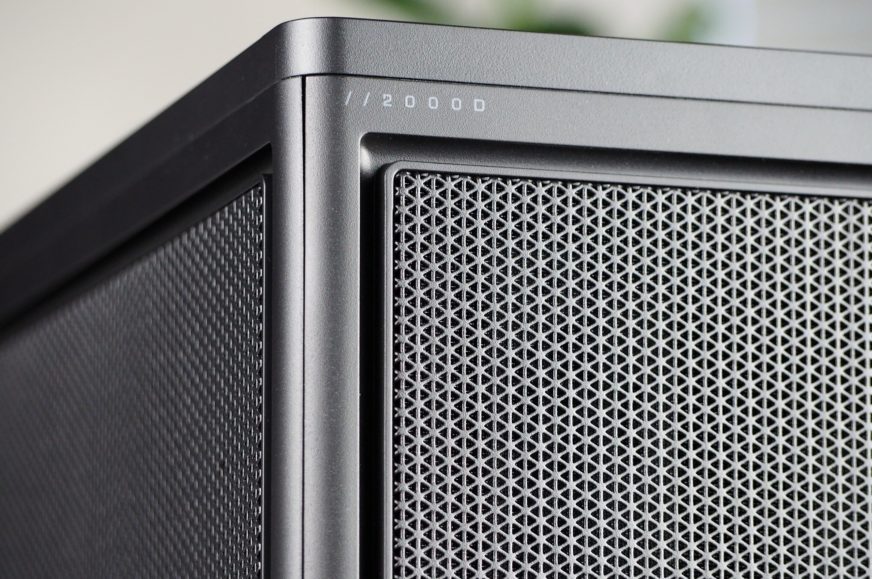Conclusion
Although the choice of components for SFF cases is often limited to a certain size, this is not the case with the Corsair 2000D Airflow. Not when it comes to a graphics card or CPU cooler. Aside from the fact that this case only takes up a very small area on the desk/ground, it can also impress with huge perforations on each side. We’ll break down the sum of all the positives and negatives in this review, which traditionally includes cooling tests as well.
Conclusion
Although there is no shortage of perforations and cool air supply from around the case, it is harder to get the heated air out from inside the case. In fact, at higher fan speeds of the front intake fans, the graphics card heats up even more than at lower fan speeds. By removing the dust filter in front of the graphics card intake, you can lower the temperature of the graphics card by a few more degrees. CPU cooling is weaker in the tested build, but you can improve this by using a liquid cooler, which the case is ready for. I would even say that its presence was counted on.
Even though much of the case is “leaky”, you don’t have to worry about dust being sucked in. Four sides are equipped with a fine dust filter and the fifth, rear side, has a removable thinner filter. That’s a solid dose of dust protection in the price range. Access to the case is both tool-less and very easy thanks to a click-on system. You can also secure them preemptively with screws at the back when transporting, but the panels hold firmly even without them. However, the tested case sample has a problem with the side panels not being flush against the front panel. At the bottom and the top, they are slightly diverging and so there is an unwanted gap. On the other hand, Corsair managed to make the interior to an excellent standard. The perimeter plates are thick but mainly strong.
Even though the case has a smaller volume, the layout of the components is well thought out. Thanks to this, you can install larger sized hardware in the 2000D Airflow such as a 3-slot graphics card, a 360mm liquid cooler radiator, or a Noctua NH-D15 tower CPU cooler. With such large tower coolers, however, you need to be careful about the thickness of the fans used behind the front panel. Standard thickness fans might already clash with them, so Corsair supplies three “Slim” fans in the RGB variant of the case. In fact, their thickness is only 15 mm.
If you don’t have any fans at home and you are thinking about buying the Corsair 2000D Airflow case, I would recommend to choose the RGB variant of the case. There aren’t as many thin fans on the market as the standard 25mm thick ones. For 40 euros extra you get more space in the case in addition to the three lighted fans. The actual installation of the components was not as difficult as it may seem. However, it’s already more complicated to manage the cabling, due to the crammed hardware on each side. The case will forgive you some of the mess, though. Even though it’s perforated on each side, you can hardly see inside.
Although the Corsair 2000D Airflow did not reach the top ranks in graphics card or CPU cooling, the overall design and wide range of options despite its smaller size earns it the “Approved” award.
English translation and edit by Jozef Dudáš
| Corsair 2000D Airflow |
| + Fine dust filters |
| + Almost no compromise in the choice of components |
| + Three 2.5" storage drive positions |
| + Presence of USB Type-C connector (10 Gbps) |
| + Almost flawless build |
| - The side panels are not flush |
| - Weaker cooling performance |
| - Fans only optional |
- Contents
- Exterior
- Interior
- Test methodology
- CPU and GPU cooling tests
- Motherboard cooling tests
- SSD cooling tests and under-ceiling temperature
- Conclusion










This is another example of stock fans being installed the wrong way. The case fans running as exhaust would help GPU thermals instead of worsening it.
Of course. The strong disproportion of intake to exhaust fans is probably done for aesthetics (through a glass front or perforated screen the light shining through “looks nice”). Well, you make what’s in demand, and when cooling efficiency is far behind how the build looks visually in the priority list… Strong positive pressure is still usually defended by less pollution due to dust, but I don’t know. I’m a bit worried that over time there might not be an alternative in which you can move those fans to different (exhaust) positions according to how they make sense from a functional standpoint.